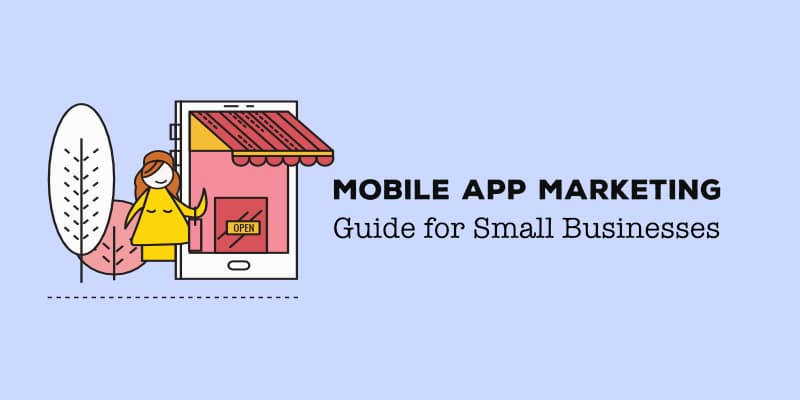
One of the best benefits of having a mobile app for your small business is that it is almost like having an open-line to each of your customers; a means for you and your customers to communicate directly with each other. And part of this communication should, naturally, be in the form of marketing, except now you don’t have to worry too much about whether your message is actually reaching your customers. An added benefit is that you are also more easily able to see the impact of your marketing efforts via your app, in the form of app engagement, and the redemption of offers exclusive to app users.
We have previously written about app promotion strategies, but this was focused only on creating awareness of your app, and getting users to install and use it. In this guide we will look at how you can use your app to market and grow your business, because while having an app is like having an open-line to your customers, it doesn’t benefit either of you if you aren’t actually communicating via this open-line.
An Apptentive study published earlier this year found that:
Of companies that saw their levels of customer loyalty decrease a great deal over the past year, two-thirds (66%) don’t have a mobile app. Companies with a mobile app reported lower levels of decline in customer loyalty over the last year.
Part of the reason for this is that customers are more loyal to business who engage with them – either through social media or a mobile app – and customers are also becoming more responsive to personalisation. Although the image below highlights the best practices of marketing to Millennials, the figures for Gen X will be only slightly lower since, like Millennials, they favour online shopping and the use of smartphones and tablets.
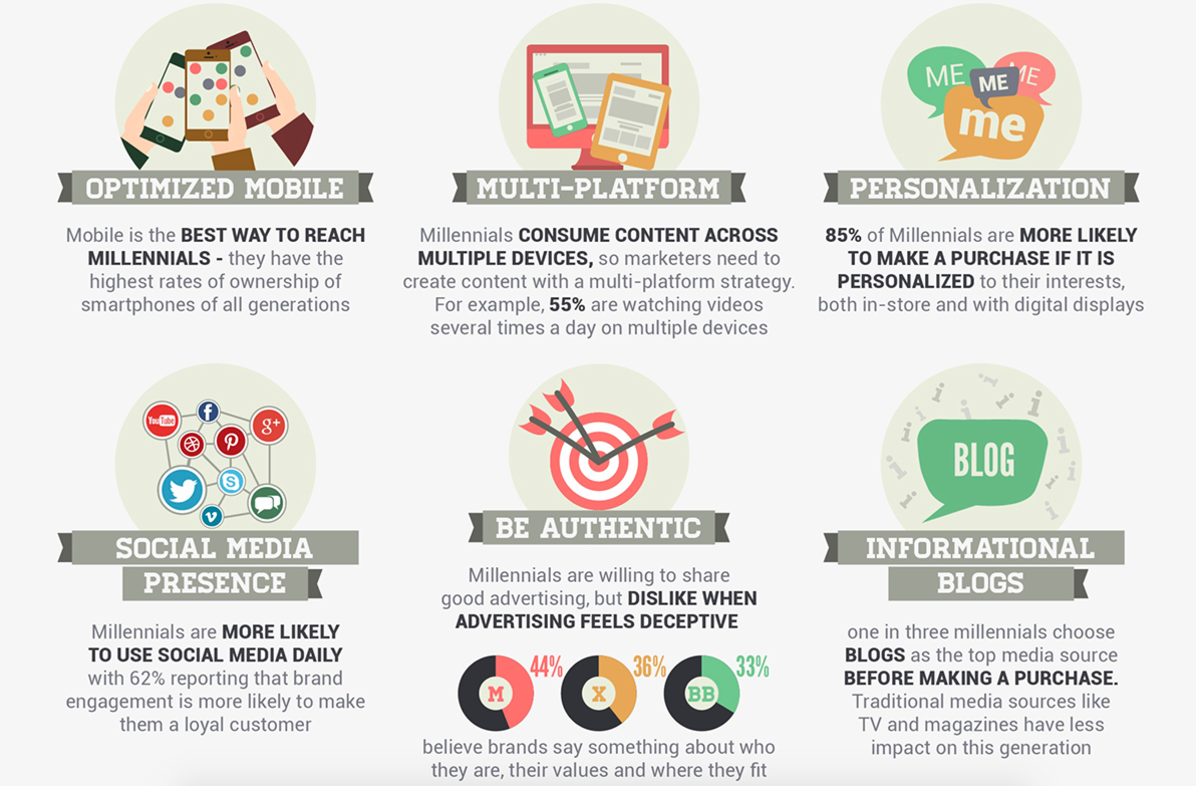 Source: USCDornsife
Source: USCDornsife
Mobile apps are very well suited to the personalisation of marketing, offers and communication, but the success of this for each business depends on how much effort you put into it, and how well you manage it. In this article we will not only discuss where your marketing efforts should be focused within your app, but also which aspects of these are good for personalisation. As we will mention a few times, personalisation is not just about addressing your customers by name, although that is a good start. Personalisation is more about tailoring your communications, offers and promotions according to each user’s preferences and past behaviour; and in order to do this you need to not only analyse user behaviour in your mobile app, but also collect some personal information, and then segment your users accordingly.
Accenture’s Holiday Shopping Survey found that 43% of UK shoppers (54% in the US) are open to sharing personal information and shopping preferences with retailers in order to receive personalised offers, up from 35% in 2015. However, although most consumers feel that personalization shows that the business respects them, 25% of consumers do feel it is a violation of privacy, so you should always err on the side of caution and only collect information you need, and that customers consent to. What small business may find is that they have a better response to personalised coupons and offers than to blanket promotions marketed to all customers, and where this is the case, it makes the extra effort required to set this up worthwhile.
Push Notification Marketing
As stated earlier, having a mobile app for your small business is like having a direct communication channel with your customers, and push notifications are the chief communicators.
When used correctly.
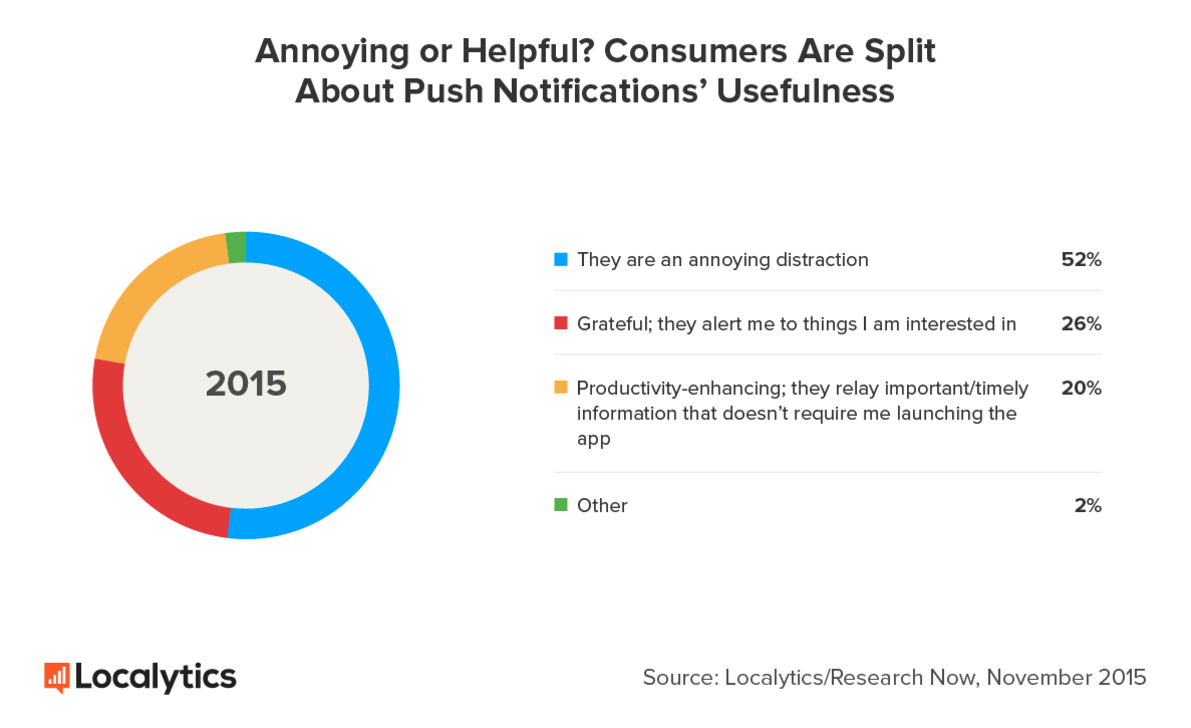 Source: Localytics
Source: Localytics
Push notifications are in the unenviable position of being loved and hated in almost equal measures: 52% of consumers find them annoying, while 48% find them useful or helpful. And unfortunately, users often choose not to opt-in to receiving push notifications based on their experience using other apps, not your own. This, however, should not deter you from using push notifications because there are multiple benefits that flow from using push notifications properly, both for you and your customers.

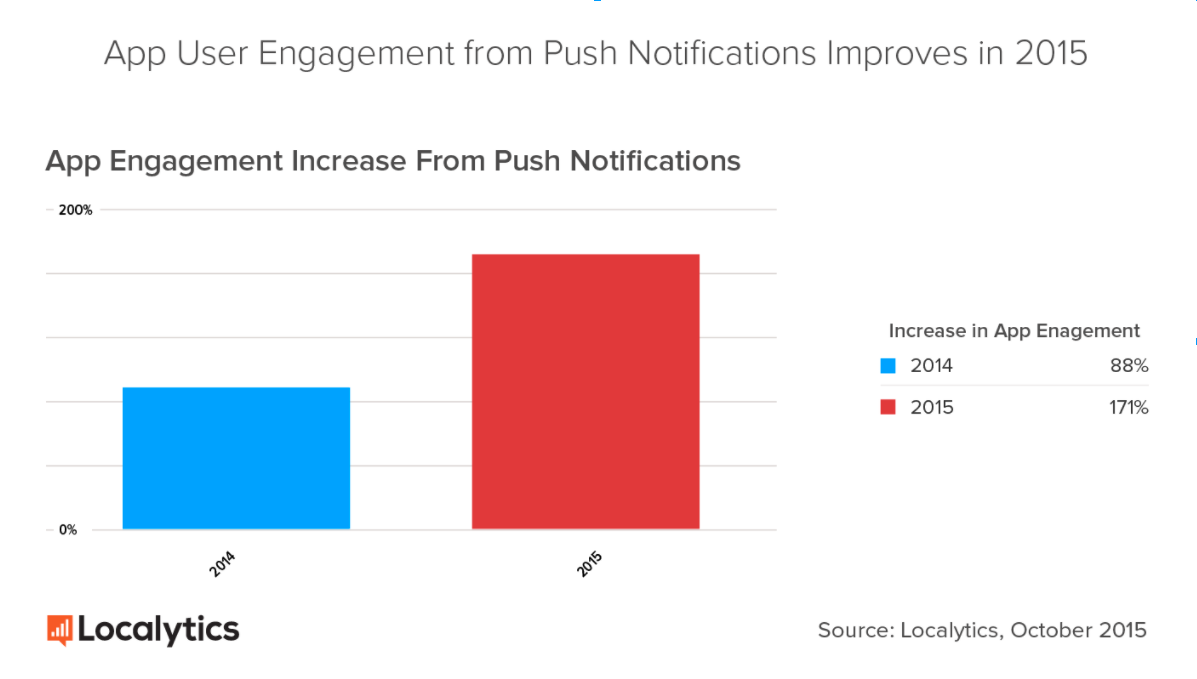 Source: Localytics
Source: Localytics
A study by Localytics found that push notifications led to a 171% increase in app engagement (up from 88% in 2014), with users who had enabled push notifications launching specific apps 3x more frequently each month than users who had not enabled push notifications. Additionally, users who had enabled push notifications were also more likely to continue using the app, with 37% of these users still using the app after 90-days, compared with only 11% of users who did not have push notifications enabled. Finally, the click-through rates (CTR) for push notifications are also increasing, if slowly, with the average rate now at 10.2%, up from 8.2% in 2014.
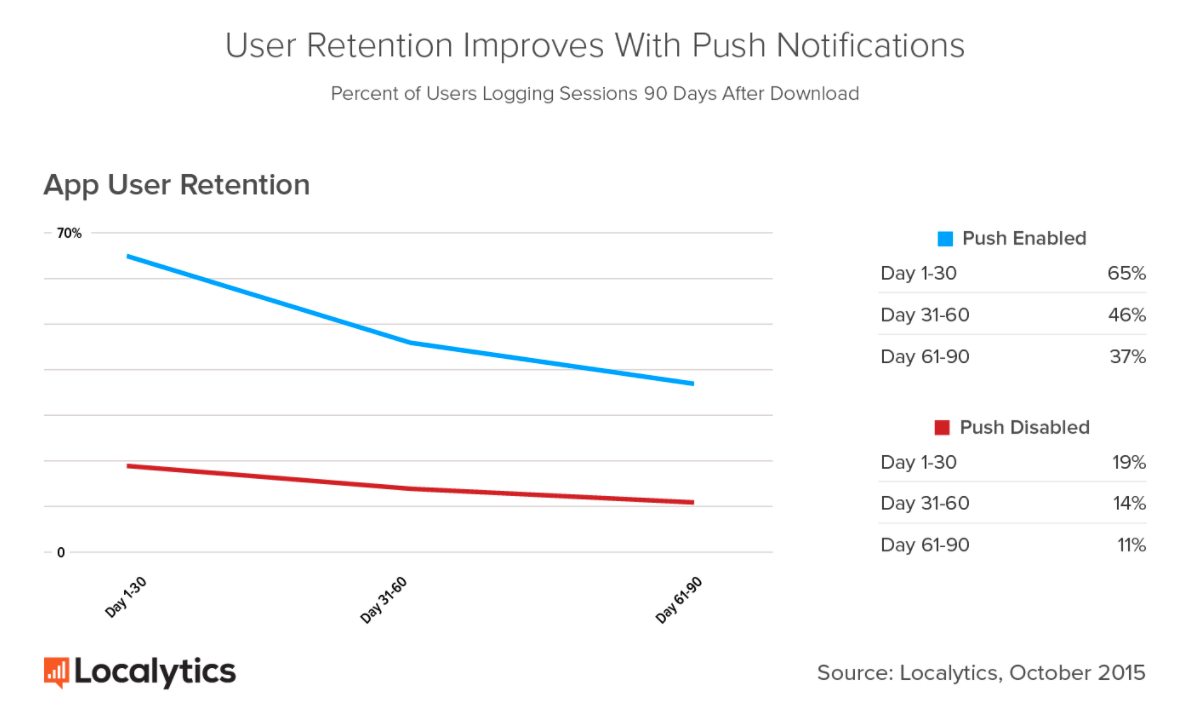 Source: Localytics
Source: Localytics
These figures show that despite some users finding them annoying, push notifications are a valuable – and low-cost – tool for marketing directly to your customers, keeping them engaged with your app, and your business.
We started this section with the caveat that push notifications are only valuable when used correctly, so we need to now clarify best practices when using push notifications.
Best Practices
Easily the biggest annoyance of push notifications is overuse – sending out too many in too short a period. How many is too much? There is no definitive answer since the tolerance threshold for each user can be expected to vary.
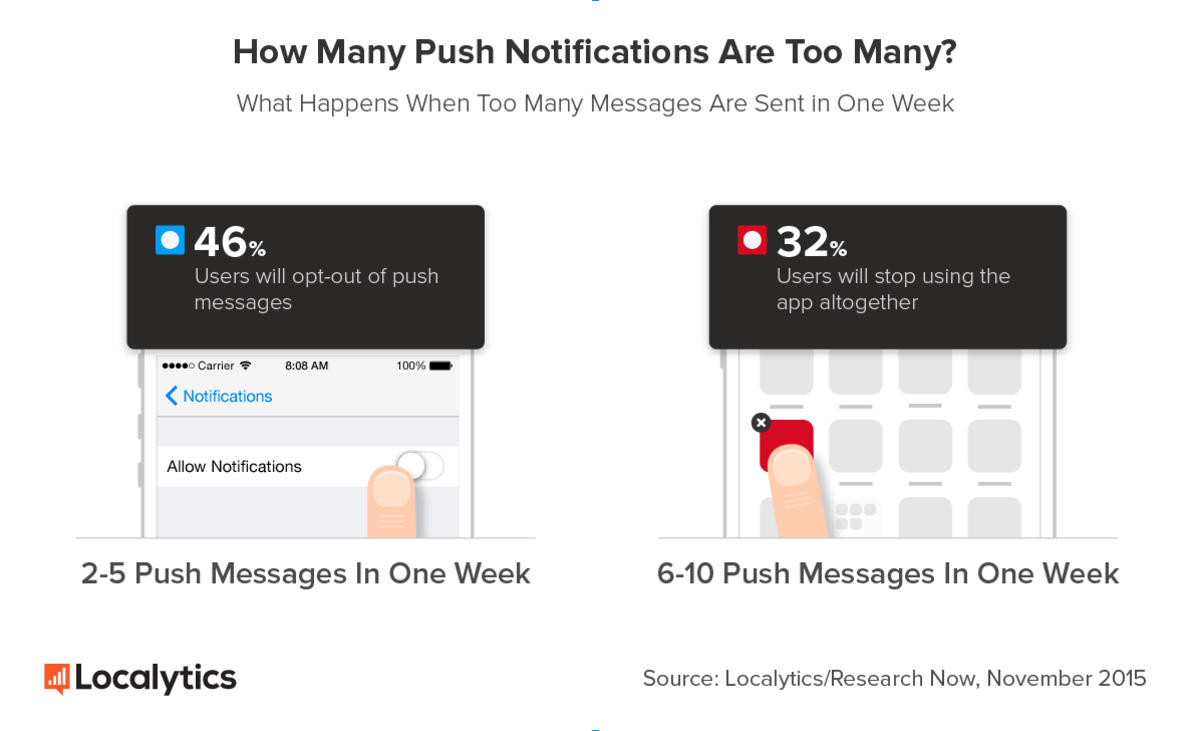 Source: Localytics
Source: Localytics
However, a survey conducted by Localytics as a follow-on to their study discussed above had 46% of respondents indicating that they would disable push notifications if they received between two and five messages in one week, with 32% stating that they would stop using an app completely if they received more than six push notifications in one week. So unless your intention is to completely alienate a large number of your customers, you probably don’t want to send out more than one push notification a week. This doesn’t sound like much, but by following the other best practices we’ve yet to discuss, you can be assured that the value of this solitary push message will still be high.
Opt-in & Opt-out
The norm is to prompt users to opt-in to receiving push notifications when they launch your app for the very first time, but if it is possible, you should test prompting users only after they have used your app 1-6 times. Doing so not only gives you a chance to build trust with your users, but it could also see the number of users who opt-in increase by between 35% and 70%.
 Source: Localytics
Source: Localytics
If you are unable to do this, you should instead focus on highlighting the benefits of opting-in in your app description. Clearly list these – in point form – in your app description, possibly including a screenshot of a sample push notification. Be as specific as possible, and always completely honest; avoid hyperbole, and update your app description whenever you change any of the benefits. You should remind users too that they can opt-out at any stage, and consider including brief instructions on how to opt-out.
Audience Segmentation & Push Notification Personalisation
Marketing is most effective when it is targeted – right person, right time, right message – and you should remember this when using push notifications for marketing purposes. While some of your campaigns might be suitable for sending through to all users, you should be looking at campaigns that target specific users and user behaviour. By way of example: a free shipping offer may appeal more to customers who have previously bought from you via your app, while those who have never made a purchase before may respond more positively to a discount off their first purchase. Similarly, a salon owner is likely to see better engagement if a discounted colour offer is only sent to customers who have previously had their hair coloured, rather than all customers including those who have only ever come in for a cut and style. Try to create audience segments based on as many of the following as possible:
- Age
- Gender
- Location
- Product(s) most frequently purchased, and category. For serviced-based businesses, segment according to service(s).
- How frequently they use your app, including most common day and time
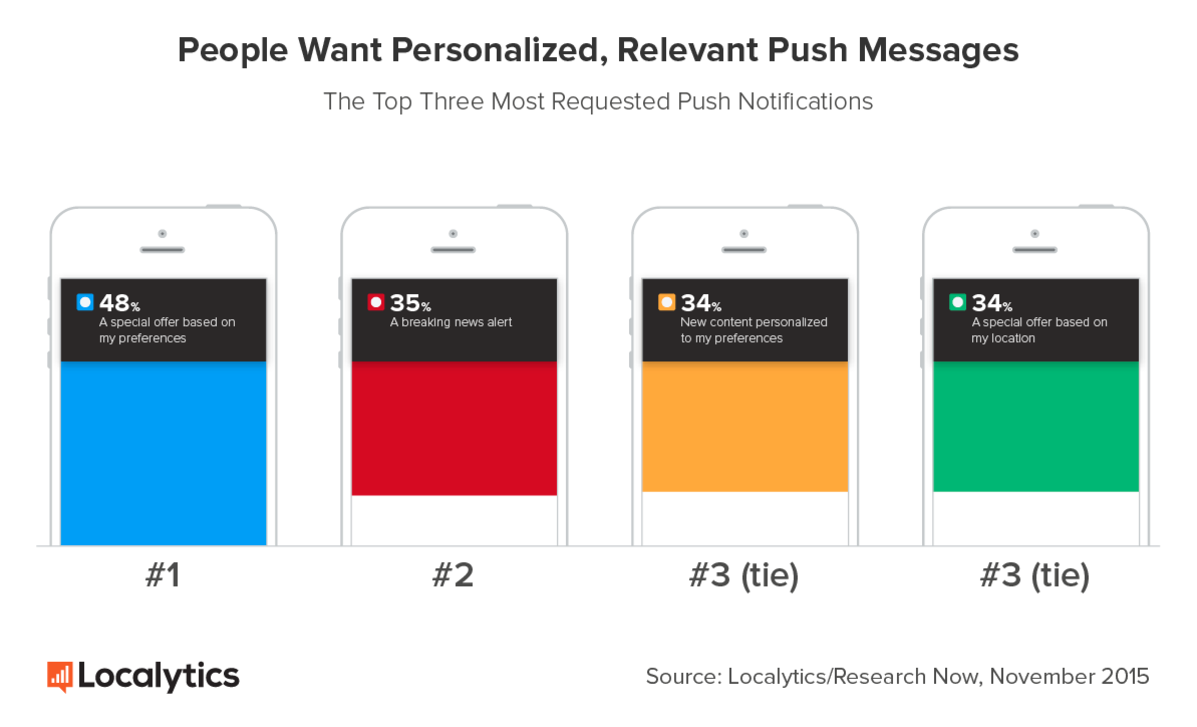 Source: Localytics
Source: Localytics
Users always respond better when the push notifications they receive are somewhat personalised, not necessarily addressing them by name, but by being relevant to them based on their preferences, or past behaviour. You can make it easier to do A/B testing later by further splitting each segment into two groups of equal numbers. One way of improving your segmentation is by getting your users to provide you with additional information about them, either by getting them to register in order to use your app or by asking them to complete an in-app form. The less information you ask for, the more likely users are to provide it, especially if you are open and honest about what you will use the information for. What you should ask for is:
- Name
- Location – suburb or town only. If you have an online store, use the shopping registration process to collect full address.
- Gender
- Age – only ask for date of birth if you intend sending birthday offers to your users, otherwise only ask for age range.
This process is also the ideal opportunity for you to ask for permission to send your users promotional information via push notification, and to then remind them to enable push notifications for your app.
Timing
We have previously discussed the frequency of push notifications, but timing is an equally important factor to consider. Timing is not only about whether you send the notification out ahead of time, but also about what time you send it. You will need to conduct your own tests to discover whether your customers respond better to 1-2 days notice versus same-day notice, but when it comes to actual time, 10am-1pm are the optimal times for sending out push notifications. However, if you are an online store shipping to multiple territories around the world, you should batch your notifications according to the local time of any international customers; nobody wants to be woken by a push notification coming through at 2am, no matter how great the offer.
A/B Testing
It is impossible to know what messages your users will actually respond to, and reading articles on how to craft the perfect message will certainly help, but not as much as good old-fashioned A/B testing. If you have properly segmented your users, and then further split them into two groups of equal numbers, you will have the perfect foundation for A/B testing – you can do A/B testing without segmenting your audience, but considering the benefits offered by segmentation and personalisation, this is not recommended. A/B testing can be run using:
- the same offer, just with different wording used in the notification,
- completely different offers (free shipping versus a discount coupon), and
- messages sent out at different times, on different days.
The purpose of A/B testing is to see which message generates the highest rate of engagement, where engagement is either users clicking on a link in the message, or completing a transaction, depending on the message itself. Assess what impact the length of the message has, along with which phrases and action verbs result in higher engagement rates: do users respond better to “One day only” versus “Today only”, etc.

Types of Push Notifications
Although marketing via push notifications benefits both you and your customers, the messages you send out should always focus on the benefit to the customer; most of your customers won’t really care that it is Joe from the Bristol branch’s birthday, or that Peggy from Reception just became a mother for the first time, and even if they do, push notifications is hardly the way to be sharing this information. Instead, focus on the following:
Announcements
The only personal announcements should be in the form of a restaurant announcing a new chef, a bar welcoming a new mixologist, or a salon/spa introducing a new somatologist or stylist. Especially if any of these new appointments are well-known within their industry. Announcements via push notification should be limited to news that affects your customers: a change in your business hours, the introduction of a new range of products (or the discontinuation of existing products/services), etc. Although it might seem like the perfect opportunity for restaurants to announce their daily specials, the fact that customers don’t react well to daily push notifications suggest you may be better off using this to only announce a popular dish that isn’t always available. Before you send out a push notification, always ask yourself: how does this benefit my customers?
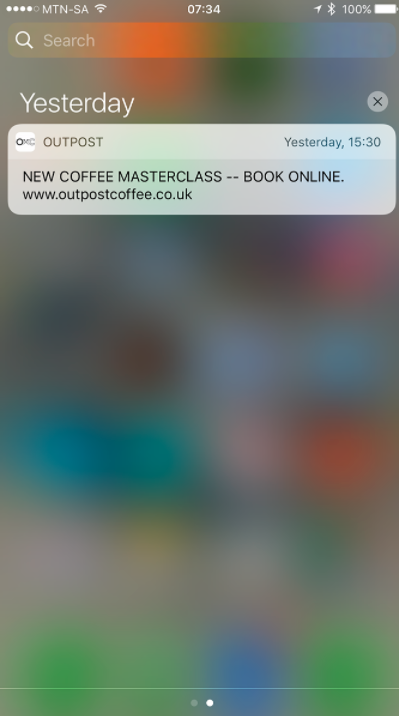
Outpost Coffee cleverly uses push notifications to announce new Master Classes for those interested in learning how to brew the perfect coffee. The only way this could have been better is if booking took place within their app, with the link included in the notification deep-linking directly to the booking page.
Sales, Special Offers & Coupons
Technically these are announcements, but they are also more transactional than informational, and when used correctly offer the biggest benefit to you and your customers. In the past you may have announced a sale by slapping a red “SALE” banner in your store window, or selling a kidney so you could afford a quarter page ad in the local newspaper. Nowadays you have hopefully switched to online and social media advertising, even if you’re still not completely sure they are being seen by the right people. Sending promotional messages via push notification helps amplify your message, with some assurance that they are being sent to people with more than a passing interest in your business. Combine that with audience segmentation, and you’re even closer to having your message seen by the right people.
When sending out announcements for a sale or promotional offer – and when sending out product, service or category specific coupons – you will see a far better response if you send it to segmented users, rather than all users. Even when the offers are valid throughout your store, or across a broad range of categories, send one message to users who frequently open your app, and a different message to users who haven’t opened your app in some time (but still have it installed). Another important point for these push notifications is: make use of deep-linking whenever the offer only applies to a specific item or item category. Deep-linking is the use of URIs that link directly to specific pages within the app, rather than simply launching the app and loading the default page. This reduces the number of steps your customers need to take in order to make use of the promoted offer.
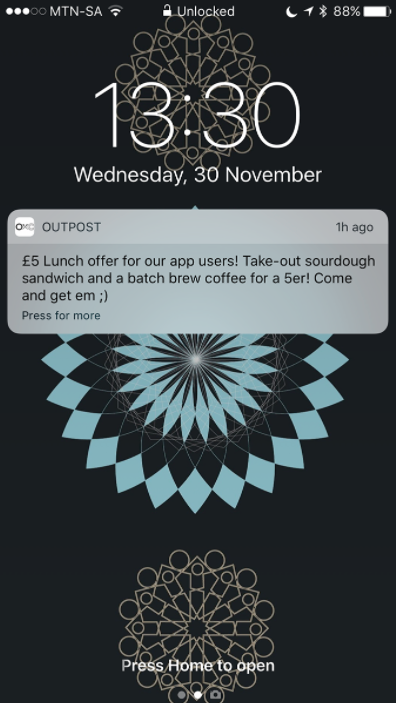
Outpost Coffee again, this time with a lunchtime special offer – the timing of the notification was good, the offer is clear, and the message isn’t too long.
Reminders
Reminders via push notification can either be part of a multi-person campaign, sent out to various segments of your users to remind them of an ongoing offer, or a specific service/product that you are trying to increase awareness of, or they can be highly personalised and only sent to a few individuals each day. The latter option is perfect for salons, medical practitioners, and any other business where customers have to make an appointment. Instead of having to call each customer to remind them of their appointment, or risk them forgetting and not showing up at all, you can send reminders to customers with scheduled appointments a day – or a few hours – before the time. It is more cost-effective – and less intrusive – than a phone call, and you can even include a deep-link to your contact details in your app, making it easy for customers to contact you immediately if they have forgotten about the appointment and need to reschedule.
Online Shopping
Push notifications can provide a considerable boost to app engagement and user retention, but it is not the only tool you have at your disposal. Any business selling physical products should consider including an e-commerce function in their mobile app, allowing users to easily browse and order products. Naturally, this isn’t as simple as just adding the functionality to your app, but requires you to address the following:
- How will shipping be managed?
- What areas will you ship to?
- Will shipping be free, or will there be a cost involved?
- Will customers be able to purchase all items you normally sell, or only a limited range?
- What forms of payment will you accept?
- How will you keep track of stock and the quantities of each item available?
Additionally, you need to provide clear and detailed product descriptions for each item in your online store, which may include product dimensions and weight, accompanied by good quality photos. It sounds like a lot of work, but most of it is purely one-off decisions that need to be made, with the rest easily managed through the implementation of ongoing processes.
While an online store can work for any business with physical products to sell – and even salons, barbers and spas sell physical products, even if the range is small – bars and restaurants can still benefit from a mobile app by replacing the online store function with an interactive menu. Instead of adding a flat PDF version of your menu to your app, create a digital menu where you aren’t too constrained by the limitations of space, allowing you to add detailed descriptions for each menu item, and use high quality images. An alternative to hiring a professional food photographer would be to invite your customers to submit their own photos of your menu items, for the chance to win a free meal.
Sales, Special Offers & Coupons
We have previously discussed the use of push notifications and deep-linking to announce and promote sales, special offers and to deliver coupons, but this only works for customers with push notifications enabled. What about customers who never enabled push notifications?
Your online store should ideally be divided into categories and subcategories, making it easier for users to quickly navigate to the range of items they are interested in. While you can, and should, highlight sales and special offers within these categories, you can also promote quick and easy discovery of current promotions by adding a separate category to your main menu, ideally positioned above all the other categories. The same method can be used for coupons, but try to keep coupons separate from your other promotional offers, and ensure that the wording on your coupon clearly states whether the coupon(s) can be used in conjunction with other promotional offers.
Deliveries
Deliveries – or shipping – can be especially difficult for small businesses when you have to stretch your already limited resources to now accommodate the picking, packing and dispatching of online orders. And with major online retailers offering same and next day delivery, customers are becoming increasingly reluctant to wait several days for their order to arrive. You shouldn’t be trying to match the delivery options of major retailers, but you should be offering fairly fast delivery that customers are able to track. Clearly indicate in your app, and your invoices, what the standard delivery time is, and your customers may also appreciate you listing a cut-off time for orders – i.e. orders placed after a certain time will only be dispatched the next working day, etc.
If all items ordered online are picked from your store stock, rather than from an external warehouse, you could investigate the possibility of allowing customers to pick up their order in-store. Some customers will love the convenience of being able to place an order online during the day, and then collect the order on their way home after work. Remember that customers who select this option are unlikely to want to be kept waiting; have a cut-off time for these orders, and have a central location in-store where they can collect.
Video
We write about video in many of our marketing posts, and that is because it is a powerful marketing tool, especially with certain segments of customers. Video can be incorporated into various sections of your app, but you should always consider including them in the online store section of your app. These videos can either be product demonstration videos, embedded just above or below product descriptions, or for clothing retailers, they can be video “lookbooks” showing off the latest arrivals, and how to co-ordinate them.
Wish Lists, Shopping Lists & Abandoned Carts
Adding the ability to create wish lists or shopping lists inside of your app doesn’t only benefit your customers in that they can quickly find items they have previously liked – but not bought – or items they purchase on a regular basis, it also benefits you in that you are presented with a great opportunity to market to these customers with highly relevant information. These include:
- Alerting them via push notification or email of a price reduction on the item(s).
- Sending them a personal coupon for any items that have been in their wish list for more than a few weeks.
- For items you won’t be stocking again, send them a “Last chance to buy” announcement as soon as stock levels drop.
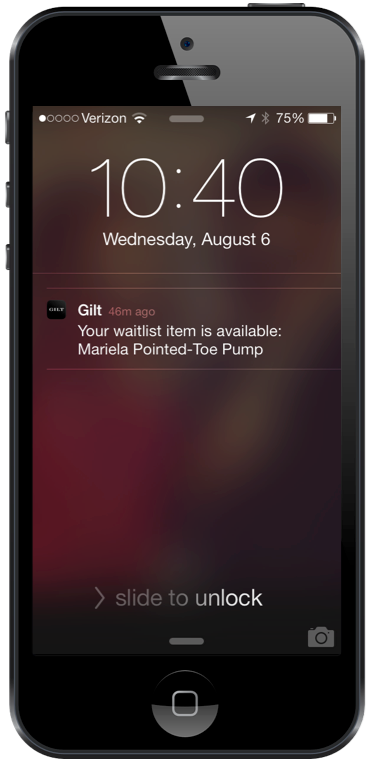
Gilt allows users to add unavailable items to a waitlist, and once the item becomes available again, a push notification is automatically sent out to users.
Finally, retailers have previously seen an increase in sales when sending out automated email messages to customers who have placed items in their online cart, but never completed checking out. Why should this not be the same with mobile shopping apps?
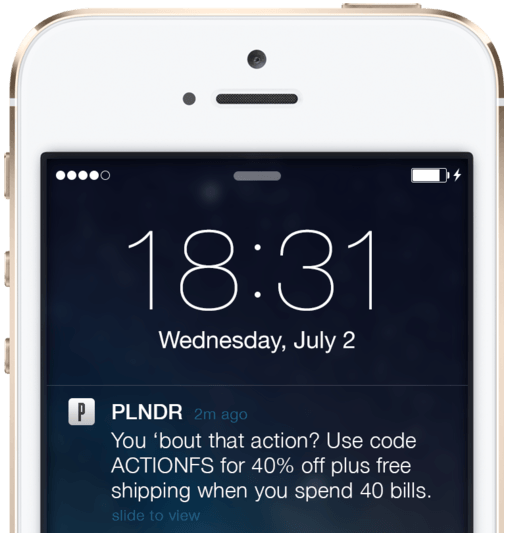
Plndr saw an 18% increase in completed sales when they started sending out personalised push notifications to users who had abandoned their cart.
Geo-Targeting
In simple terms, geo-targeting is the use of location-based push notifications. In addition to a regular campaign of push notification marketing, businesses with a largely local user-base can run a geo-targeted push notification campaign, where notifications are only sent to users when they are within a specified geographical area.
The first step when implementing a geo-targeted campaign is to define the geographical area, which should be a radius of 50m or so, with your business at the centre. Depending on your location, this can be extended slightly to include high-traffic areas nearby. You then need to decide on the offers and announcements you will push to users within this area, along with the wording and frequency. Many of the best practices for push notifications should be followed too when using geo-targeting, since – despite the different names – they are essentially the same thing.
Special Offers & Coupons
Although geo-targeting can be used to announce current sales and promotions, you risk duplicating information you have previously shared via your regular push notification campaign. And excessive messages annoy customers, and they will either disable push notifications – reducing the effectiveness of your mobile app – or they will delete the app. Avoid this by limiting your geo-targeted announcements to once-off, time limited offers and coupons that aren’t announced anywhere else. Another way of looking at them is to acknowledge that these aren’t actually promotional offers, but rather incentives that are delivered to exclusively to customers who are in close proximity to your business, encouraging them to actually visit your business right now. Focus on using phrases like “Today only” or “Offer ends in 1 hour”, and “Exclusively for you” and “In-store only” – these not only highlight exclusivity, but also encourage customers to act immediately.
Although geo-targeting is meant to drive sales by encouraging users to visit your physical location, rather than driving sales through app engagement, there is still a need to make use of deep-linking with this type of push notification. If customer are meant to produce a digital coupon when making a purchase in-store, the link included in the notification should be a deep-link, taking the customer straight to the coupon, rather than just launching the app and leaving them to try and find the coupon.

Audience Segmentation
Segmenting your audience is as important with geo-targeting as it is with regular push notifications, helping to keep all messages that are sent out relevant to the recipient. Follow the same guidelines outlined under push notifications, and if possible add another segment for users who are in your defined geographical area almost daily: these are probably users who work close by, and creating a segment just for them will help minimise the risk of annoying them by sending them notifications every day. Additionally, you should also check that your geo-targeted notifications are only ever sent out during your regular business hours; remember that these announcements are primarily aimed at getting users of your app to visit your physical location, not merely prompting them to engage with your app.
Loyalty Program
Loyalty programs work – if they didn’t, businesses would not continue to roll them out, and your wallet would not be half full of loyalty cards. A study by the Collinson Group found that a loyalty program was among the top three offerings that would encourage customers to spend more with a particular brand.
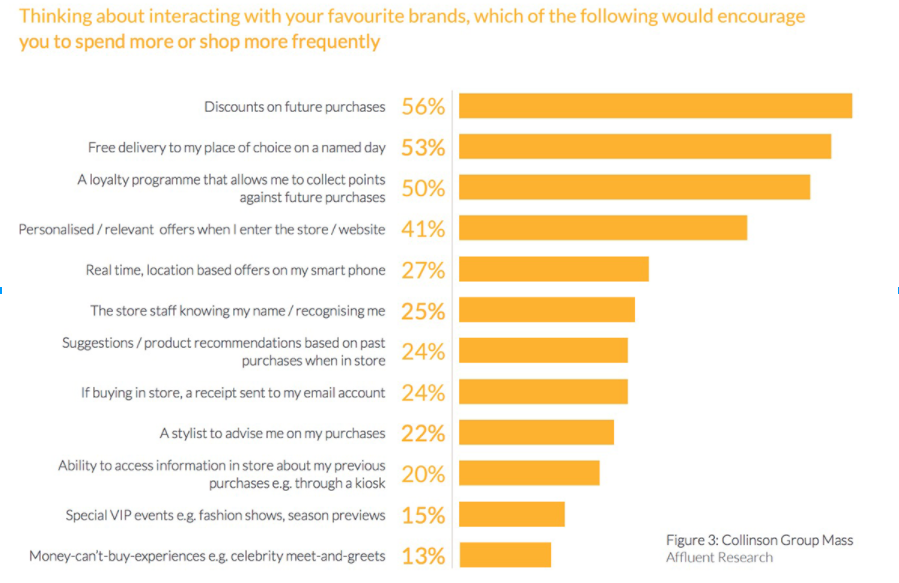 Source: ICLP Loyalty
Source: ICLP Loyalty
But loyalty programs are not without their own set of challenges, which each business needs to work at overcoming. While 60% of customers believe in the loyalty programs they participate in, 33% of Millennials dislike loyalty programs because of the number of cards they end up having to carry around. Additionally, 70% of customers do not sign up for new loyalty programs because of inconvenient registration processes.
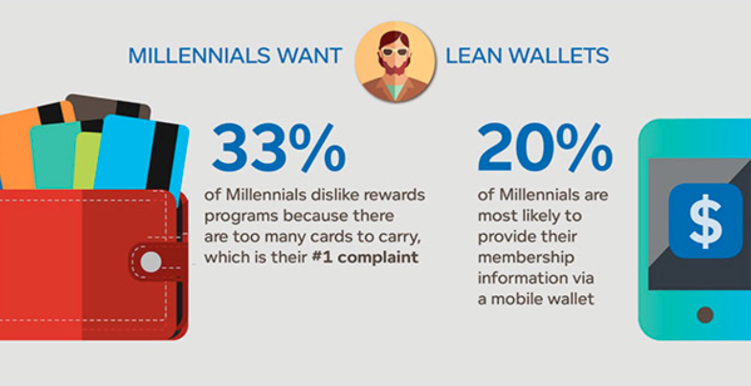 Source: Vantiv
Source: Vantiv
Switching from a physical loyalty card to a digital loyalty card – inside of your mobile app – will definitely make your loyalty program more appealing, while reducing your overheads, and simplifying the enrollment process for both you and your customers.
Audience Segmentation
The personalisation and relevancy of communication from business to consumer is receiving more attention from marketers, and while customers aren’t demanding personalisation, they are responding more to businesses who employ some form of personalisation. This is especially true when it comes to marketing communications and marketing offers, and loyalty programs are not exempt from this.
Oversimplifying your loyalty program enrollment process can be a liability if you collect too little information from your users, making it difficult for you to personalise their experience. Using the registration or in-app form process discussed under push notifications can eliminate this, while still being a simple process for users, which they can also do whenever it suits them. You can personalise your loyalty program further by simply asking users what types of rewards they would prefer, instead of offering a default one-size-fits-all reward. Offering only one type of reward might be convenient for you, but it doesn’t necessarily appeal to all customers, some of whom may prefer a discount coupon to use as they please. And by incorporating your loyalty program into your app you make this possible, without requiring extra resources on your part, as long as you are properly segmenting your audience in your loyalty program, and measuring the performance of each segment and reward type. Remember that what isn’t measured cannot be managed.
One way to make it easy for new customers to enrol in your loyalty program, and to increase the number of people using your app, is to create a simple mobile app landing page, with direct links to your app on the relevant app store, and a QR code that, when scanned, also auto loads your app on the relevant store. This landing page and QR code can be shared via email and social media, but should also be accessible in-store for customers who want to immediately start benefiting from your offers that are exclusive to app users.
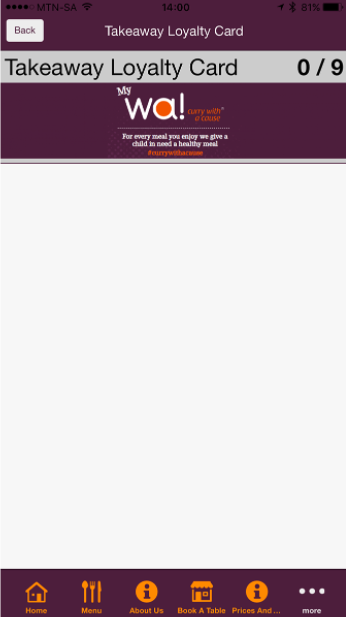
Wa! Curry has two loyalty cards, one for takeaway meals, and one for sit down meals, and both cards remind you of their commitment to giving a needy child a healthy meal for every meal you enjoy – double the incentive to keep supporting them!
Booking Forms
The final essential mobile app marketing tool we’ll be discussing in this guide is the inclusion of a booking form in your app. Though this feature isn’t of benefit to all businesses, it is absolutely essential for any business that relies on customers scheduling an appointment: from salons and spas, through to restaurants and repairmen.
As with any online form, aim to keep things simple by asking only for the most necessary information:
- Name
- Contact details
- Service required
- Preferred date and time
Unless your app integrates directly with your booking system, you should ensure that customers understand that the booking form only constitutes a request, and that bookings are only confirmed once you have followed up with the customer. This also means that you should regularly check on submitted booking requests, and promptly follow up with each customer submitting a request. Failing to contact a customer who has communicated with you via your app is not only rude, it damages any trust customers had in you in the first place:
55% of consumers who leave feedback in a mobile app are not likely to remain a customer if their feedback goes seemingly ignored
Apptentive Loyalty & Feedback Survey
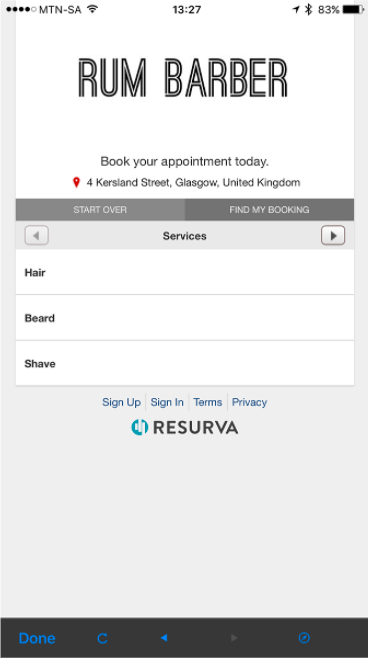
The booking form in Rum Barber’s app cleverly redirects to the professional booking system on their website, without ever leaving the app. Although this system requires more steps to be completed, it is still relatively simple, and by integrating with their in-store booking system, there is no need to contact customers to confirm a booking, except to possibly send a reminder push notification on the day of the booking.
Conclusion
Push notifications (and geo-targeting) are two powerful marketing tools available to businesses with a mobile app, but since this method is strictly opt-in, the challenge for all business owners is to convince users that they won’t be bombarded with excessive, and irrelevant, notifications. But there are still many users who are quite happy to receive push notifications, and this number can continue to grow if businesses not only commit to following the best practices outlined in this article, but actually following through with that commitment. We have also discussed how personalisation can have a very positive impact on customer engagement, and responsiveness to offers, and this will continue to be a positive for business who get it right. If you aren’t already experimenting with personalisation, we hope you will take note of the ideas presented here, and begin exploring how your business can implement some of them, both within your app and in your other marketing initiatives.
Keeping users engaged with your app is an ever-present hurdle, and we would love to hear what you are doing to keep users engaged with your small business app.

Last Updated on April 13, 2023 by Ian Naylor
4 thoughts on “Essential Mobile App Marketing Guide for Small Businesses”